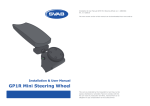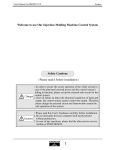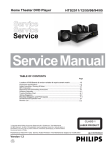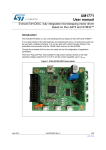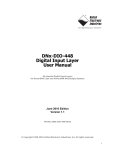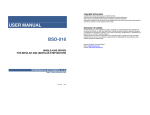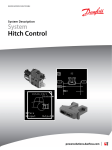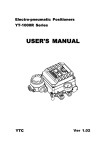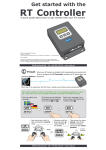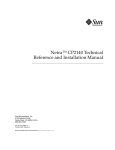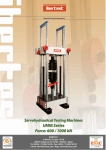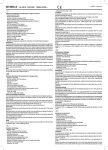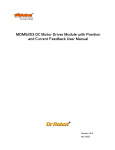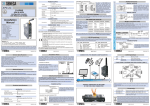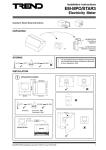Download GP Controller
Transcript
User Manual GP Controller 1 User Manual GP Controller 3 User Manual for GP Controller (GPC) Version 2.2 (090626) Art.nr: 630013 This work is protected by the Copyright Act and may not be copied, distributed or amended. Failure to comply with this Act can result in prosecution and fines, imprisonment or an obligation to pay compensation to the author/owner. Table of Contents 1. Introduction....................................... 9 1.1 Analog Axis..................................... 10 1.2 Digital Input Signals......................... 10 1.3 Input.............................................. 11 1.4 Output........................................... 11 1.5 Valves............................................ 12 1.6 Hydraulic function............................ 12 1.7 Proportional controller ..................... 12 1.8 Summary........................................ 13 ? 2. Installation....................................... 14 2.1 Assembly example 1. 4-function system for forklifts........................................... 15 2.2 Assembly example 2. Control of the rotor tilt and wheels/tracks............................. 16 2.3 Example 3. Control of backhoe loader.18 2.5 Start-up settings.............................. 20 3. User Interface.................................. 23 3.1 Operating Mode............................... 24 3.2 Language Setting............................. 24 3.3 Main Menu...................................... 25 3.4 Master mode menu.......................... 26 4. Main Menu Summary........................ 27 4.1 End Levels...................................... 28 4.2 Start Levels..................................... 28 4.3 Feeder Settings............................... 28 4.3.1 Feeder End Levels....................... 28 4.3.2 Feeder’s Start Level.................... 29 4.3.3 Feeder’s Max Level...................... 29 4.3.4 Feeder’s Fixed Levels................... 30 4.3.5 Ramp Time................................ 30 4.3.6 Derivation.................................. 31 4.3.7 Feeder’s Middle Level.................. 31 4.4 Information..................................... 32 4.4.1 Firmware Version ....................... 32 4.4.2 Serial Number............................ 32 4.4.3 Display Stored Error Codes.......... 32 4.4.4 Delete Stored Error Codes............ 33 4.5 Middle Levels................................... 33 4.6 Ramp Time..................................... 34 4.7 Progressive Curve............................ 34 4.8 Lever Calibration.............................. 35 4.9 Change Direction............................. 35 4.10 Copy Banks................................... 35 4.11 Enter Code.................................... 36 4.12 Unlock Menus................................ 36 5. Master Mode Menu Summary............ 37 5.1 Logic.............................................. 38 5.1.1 In-test...................................... 38 5.1.2 Functions................................... 38 5.1.3 Outputs..................................... 39 5.1.4 Double push............................... 39 5.2 Output types................................... 40 5.3 Rippel amplitude.............................. 40 5.4 Lever Calibration.............................. 40 5.5 Hysteresis....................................... 41 5.6 Erase EEPROM................................. 41 5.7 Buzzer............................................ 41 6. Output Types.................................... 43 6.1 Output types................................... 44 6.2 Feeder outputs................................ 45 6.3 Current monitoring........................... 47 7. Logic Programming.......................... 49 7.1 In-test............................................ 50 7.2 Programing functions........................ 51 7.3 To program a feeder......................... 58 7.4 Double push.................................... 59 7.5 Import functions.............................. 60 7.6 Control a function with a function....... 61 8. Adjustment Instructions.................. 63 8.1 Set the Feeder’s Middle Level............. 64 8.2 Feeder’s Start level.......................... 65 8.3 Feeder’s End Levels.......................... 66 8.4 Feeder’s Fixed Levels........................ 67 8.5 Feeder’s Max Level........................... 68 8.6 Middle Levels................................... 69 8.7 Start Levels..................................... 71 8.8 End Levels...................................... 72 9. Optional Settings.............................. 73 9.1 Lever Calibration.............................. 74 9.2 Hysteresis....................................... 76 9.3 Progressive Curve............................ 77 9.4 Ramp Time..................................... 78 9.4.1 Ramp time, proportional outputs... 78 9.4.2 Ramp time, on/off outputs........... 79 9.5 Ripple Amplitude.............................. 81 9.6 Change Direction............................. 82 9.7 Derivation....................................... 82 9.8 Buzzer............................................ 83 9.9 Enter Code...................................... 84 9.10 Unlock Menus................................ 85 9.11 Change the Code........................... 85 9.11.1 Deactivate Menu Lock................ 85 10. Configuration Banks....................... 87 10.1 Current Configuration Bank............. 88 10.2 Change Configuration Bank............. 88 10.3 Copy Banks................................... 88 ! 11. Troubleshooting............................. 91 11.1 Input Signal Error.......................... 92 11.2 System Error................................. 92 11.3 Output Error.................................. 93 11.4 CAN-error..................................... 93 11.5 Show Stored Error Codes................ 94 11.6 Erase Stored Error Codes................ 94 11.7 Erase EEPROM............................... 95 11.8 Serial Number............................... 95 11.9 Firmware Version........................... 95 Appendix 1. Connections................................................................................................................................................ 96 Appendix 2. Common Default Settings.............................................................................................................................. 97 Appendix 3. Default Settings Banks A, C, D and E.............................................................................................................. 98 Appendix 4. Default Settings Bank B.............................................................................................................................. 100 Appendix 5. Set Up Example: Excavator with tilt rotator and extra function (1) ................................................................... 102 Appendix 6. Set Up Example: Excavator with tilt rotator and extra (2)................................................................................ 104 Appendix 7. Set Up Example: Excavator with tilt rotator, grapple and extra......................................................................... 106 Appendix 8. Set Up Example: Excavator with tilt rotator, grapple, extra and tracks............................................................... 108 Appendix 9. Set Up Example: Excavator with tilt rotator, grapple, extra and wheels ............................................................. 110 Declaration of Conformity........................................................................................................................................... 112 MENU REGISTER.......................................................................................................................................................... 114 1. Introduction What is GP Controller? GP Controller (GPC) is a control unit designed for flexible and safe proportional control of many types of processing machines. Instructions: 1. Read through the chapter to get a general idea of the system. 2. Continue on to chapter 2. The GPC has I/O ports that can be configured for variable control of most machines and by different operators. Chapter: This chapter explains the symbols used in this manual and shows how a control system is setup. 1.1 1.2 1.3 1.4 1.5 1.6 1.7 1.8 Page: Analog Axis.............................................................10 Digital Input Signals.................................................10 Input......................................................................11 Output...................................................................11 Valves....................................................................12 Hydraulic function....................................................12 Proportional controller .............................................12 Summary................................................................13 Introduction 9 Analog axis 1.1 Analog Axis Above are examples of input devices which move along analog axes. Input devices move in two directions, A or B, which the GPC refers to as Ax1, Ax2 etc. Devices have two input signal contacts and at most 7 analog axes can be connected to a GPC, with the left-hand input signals designated as Ax1-Ax4 and the right-hand input signals as Ax5-Ax7. Digital signal By using an analog axis you can regulate the speed of a hydraulic function in both its directions. 10 Introduction 1.2 Digital Input Signals A digital input can only Buttons and switches are examples of digital input signals, start/stop a hydraulic funwhich the GPC refers to as DIN1, DIN2 etc. At most 8 digi- ction. The speed is preset. tal inputs can be connected via the input connectors, with the left-hand input signals designated as DIN1-DIN4 and the right-hand input signals designated as DIN5-DIN8. A One-way port Input 1.3 Input The GPC has a 15-pin input divided into left and righthand input contacts. Both analog axes and digital inputs can be connected. For more information about input, see Appendix 1. Amperage B-output Two-way proportional port 1.4 Output The output regulates the amperage to the magnetic coils in the valves. The GPC has 9 outputs, 5 two-way proportional outputs and 4 one-way on/off outputs. For more information about output, see Appendix 1. Amperage Amperage A-output Lever position AB Lever position The two-way proportional outputs are called Out1-Out5. They control twoway proportional valves, each consisting of an A-output and a B-output, one for each direction. Proportional control uses amperage to regulate how much the valve opens, permitting variable control of hydraulic cylinder speed. The one-way outputs are called Out6-Out9. These can only control one-way on/off-valves i.e., valves that can only open or close. Introduction 11 One-way valve Two-way valve Wheel control valve Actuator Proportionalvalve Hydraulic function 1.5 Valves Various valves which can be connected to and controlled by the GPC’s output. 1.6 Hydraulic function Valves control the hydraulic functions, e.g. a hydraulic cylinder or a hydraulic motor. AB P P 1.7 Proportional controller A proportional controller (or feeder) consists of a proportional shuttle valve (or actuator) which is connected to a valve on the machine’s valve block (P). It supplies the total amount of oil needed by an attachment with several hydraulic functions e.g., a tilt-rotator on an excavator. 12 Introduction The GPC uses feeder output to control the feeder via Out4 or Out5. 1.8 Summary 1. An analog axis is linked to the GPC When the axis is activated the input receives the input signal. 2. A function links the input signal with the output to be controlled. (The GPC has 12 programmable functions, read more about these in chapter 5. Master Mode Menu Summary) 3. The output sends current to the valve. 4. The valve opens and releases oil pressure which causes the hydraulic cylinder to move. Introduction 13 2. Installation General: This chapter contains general instructions on how to install a control system. The assembly instructions are not adapted to any specific machine type or manufacturer. Instructions: 1. Assemble the system in accordance with one of the assembly examples or the supplied assembly instructions, if available. 2. Perform the start-up settings. The chapter includes four examples showing how a system can be configured and the necessary parts to be installed. 14 Installation 3. Continue to chapter 3. Chapter: Page: 2.1 Assembly example 1. 4-function system for forklifts.....15 2.2 Assembly example 2. Control of the rotor tilt and wheels/ tracks..........................................................................16 2.3 Example 3. Control of backhoe loader.........................18 2.5 Start-up settings......................................................20 2.1 Assembly example 1. 4-function system for forklifts Install the GPC where it is easily accessible and read from the driver’s seat. Install the PAMM-control unit with 4 analog axes. It is recommended that the GPC be installed so that it is grounded to the machine chassis. Part: 147510 Part: 147140 Part: 146123 Part: 146531 Fit the valve plugs on the actuator. They do not need to be fitted in any particular order. Pull in the cable and connect it to the GPC + 9-30V Couple the connectors and earth the cable screen on the machine chassis. + 9-30V Complete the assembly by connecting the supply voltage 9-30V to the brown and white wires. The cables should not be longer than three meters and must be fuse protected, they should share a 10 A fuse. The wire cross section should be at least 2 mm. The yellow and green wires are earthed to the machine chassis. These two must not exceed a length of three meters. (An insulated converter should be used on electric trucks). Installation 15 2.2 Assembly example 2. Control of the rotor tilt and wheels/tracks The SVAB Grip L8 lever replaces the machine’s standard lever and it is available in many configurations. This model has 2 analog axes (rollers) and 7 digital input signals (buttons). Part: 147100 Install the GPC where it is easily accessible and read from the driver’s seat. The GPC must grounded to the machine chassis. Part: 200183 Part: 146108 Part: 146030 A relay card can be used to connect functions to lever buttons not controlled by the GPC, e.g. horn. (Max 1A 30V DC). 16 Installation Part: 146120 + 9-30V + 9-30V Complete the assembly by connecting the supply voltage 9-30 V to the brown and white wires. The cables should not be longer than three meters and must be fuse protected by a 10 A fuse. The wire cross section should be at least 2 mm. The yellow and green wires must both be grounded to the machine chassis and not exceed three meters. Part: 147181 The APL card connects the GPC with different rotor tilt models. The coupler switch controls the tool lock on the rotor tilt. Part: 147160 Part: 146124 The APLX card connects the GPC with extra functions such as track and wheel control. Part: 302141 Part: 146143 The machine cable to the rotor tilt is connected to the APL card. It is connected differently depending on the model and machine. See the enclosed assembly instructions. Proportional shuttle valve which controls the feeder function to the rotor tilt. Valve for wheel control. The valve for track control is connected in serially with the servo hoses from the pedal, and parallel with the pedal’s P and T-connections. If the machine’s pedals are equipped with a pressure sensor, these must be moved so they are positioned after the track control block. Installation 17 2.3 Example 3. Control of backhoe loader This example shows how a customised control system can look like for complete control of a backhoe loader. This is not intended to be an assembly instruction. Sensor for the seat position, seat back and oscillation lock. GPR GND + 9-30V Sensor for the seat position, seat back and tool lock return. + 9-30V Operating valve for the 4th function Coupler GND Feeder Left outrigger Right outrigger Load retainer Lift 18 Installation Machine cable to the rotor, tilt and grapple/extra Tilt 3rd & 4th functions Wheel control 2 Prof1 levers with base. Including 7 analogue axis and 11 digital input signals. Gear shift GPR Oscillation lock + 9-30V GND Digging brake Extension Bucket Stick Boom Swing Installation 19 Language English 2.5 Start-up settings The first-time the GPC is powered on, several basic settings need to be made. The first step is to select the language. Move all levers to their end positions and press OK. SVAB Move all In the next step all the analog axes are calibrated. This is always done the first time a lever is connected and allows the GPC to control the signal type and various values which the lever will control. 20 Installation Language English Språk Svenska Language English 1. Select the preferred language using the arrow keys. 2. Save and continue by pressing the middle button. max max SVAB Move all 3. Slowly pull all levers forwards and backwards to their end positions. Continue until the black squares on the display stop flashing. SVAB Move all 4. Continue by pressing the middle button. Release the levers to their middle positions and press OK. SVAB Release t Configure the functions automatically? Configure Yes SVAB Release t 5. Release all levers so that they are in their middle positions and then press the middle button to complete calibration. (If calibration should fail or needs to be repeated, read chapter 9.1 Lever Calibration) In the last start-up setting you select whether you would like the GPC to configure the functions automaticly. Configure Yes Automatic configuration of functions involves all connected levers being linked to individual functions. The example above describes how a system with four analog axes can be programmed. (How to program GPC functions and what is involved is described in chapter 7. Logic Programming.) 6. Press the middle button to accept the automatic configuration and exit the start-up settings. Installation 21 22 Installation ? 3. User Interface General: Now that the system has been started, it is a good idea to familiarize yourself with the GP Controller’s (GPC) user interface, before additional settings are made. Instructions: 1. Acquaint yourself with the GPC’s overall menu system. (See chapters 4. Main Menu Summary and 5. Master Mode Menu Summary for more in-depth description.) The GPC interface consists of a display and three buttons. The display shows the setting options and your position in the menu system. To scroll menus and sub-menus, use the arrow keys. To select an option, use the middle button. 2. Continue to the next chapter. Chapter: Page: 3.1 Operating Mode.......................................................24 3.2 Language Setting.....................................................24 3.3 Main Menu..............................................................25 3.4 Master mode menu..................................................26 User Interface 23 3s SVAB Bank: A 3.1 Operating Mode The machine can be controlled when the system is in the operating mode. SVAB Bank: A 3.2 Language Setting The GPC has several available languages, which may be chosen in the language menu. 1. To access the language menu and change the language, press both arrow keys for approximately 3 seconds and release. Språk: Svensk Language English Language English Kieli: Suomi Language English Sprache: Deutsch Lengua: Espanol 2. Use the arrow keys to scroll through the available languages. 24 User Interface Language English 3. Use the middle button to confirm language choice and return to operating mode. Return End levels SVAB Bank: A Meny: Return Meny: End lev Start levels Middle levels Ramp time Progressive curve Lever calibration x3 3.3 Main Menu Settings are made in the main menu to adapt the system to the machine. Change direction Copy banks 1. To access the menu, hold the down arrow while at the same time pressing the up arrow three times. 2. To scroll down through the menu, press the down arrow. Return End levels Meny: Return Start levels Middle levels Meny: Return Ramp time Progressive curve Lever calibration Change direction Copy banks 3. To scroll up through the menu, press the up arrow. 4. To return to the operating mode, scroll to Return and press the middle button. User Interface 25 SVAB Bank: A Master M Return x3 x1 x2 x1 3.4 Master mode menu The master mode menu is used to make advanced settings and meant for service technicians. To enter the master mode menu, press the arrow keys according to the above combination. 1,5 s Output ty Out1 SVAB Bank: A No matter where you are in the system, holding the middle button for 1.5 sec returns you to the operating mode. Note: Changes made in the current mode will not be saved. 26 User Interface x1 x1 4. Main Menu Summary How is the main menu used? To modify the GP Controller system (GPC) to a particular machine, settings are made in the main menu. Instructions: 1. Read the chapter text thoroughly and follow the main menu in your own GPC. To enter the main menu: Press and hold while pressing 3 times. SVAB Bank: A Meny: Return x3 Tip! Note that the sub-menus in the main menu in this chapter have the same order as in your GPC. Chapter: Page: 4.1 End Levels..............................................................28 4.2 Start Levels.............................................................28 4.3 Feeder Settings.......................................................28 4.3.1 Feeder End Levels...............................................28 4.3.2 Feeder’s Start Level............................................29 4.3.3 Feeder’s Max Level..............................................29 4.3.4 Feeder’s Fixed Levels...........................................30 4.3.5 Ramp Time........................................................30 4.3.6 Derivation..........................................................31 4.3.7 Feeder’s Middle Level..........................................31 4.4 Information.............................................................32 4.4.1 Firmware Version ...............................................32 4.4.2 Serial Number....................................................32 4.4.3 Display Stored Error Codes..................................32 4.4.4 Delete Stored Error Codes....................................33 4.5 Middle Levels...........................................................33 4.6 Ramp Time.............................................................34 4.7 Progressive Curve....................................................34 4.8 Lever Calibration......................................................35 4.9 Change Direction.....................................................35 4.10 Copy Banks...........................................................35 4.11 Enter Code............................................................36 4.12 Unlock Menus........................................................36 Main Menu Summary 27 Return End levels Start levels Feeder settings Information Middle levels Ramp time Progressive curve Lever calibration Change direction Copy banks 4.1 End Levels An end level is the signal level that is sent from the output to the valve when the associated analog axis is in its end position. End levels in the main menu. To set an end level see chapter 8.8 End Levels, page 72. 4.2 Start Levels A start level is the signal level sent to the valve from the output when the associated analog axis is in its start position. Return End levels Start levels Feeder settings Information Middle levels Meny Feeder set Ramp time Progressive curve Lever calibration Change direction Copy banks Start levels in the main menu. To set a start level see chapter 8.7 Start Levels, page 71. 28 Main Menu Summary 4.3 Feeder Settings When an output is set to be a feeder, the option Feeder settings is added to the main menu. 4.3.1 Feeder End Levels An end level is the signal level sent from the feeder output to the feeder when the lever is in its end position. Return Return End levels End levels Start levels Start levels Feeder settings Max levels Information Fixed levels Middle levels Ramp time Ramp time Derivation Progressive curve Middle level Lever calibration ... Change direction Copy banks End levels is a submenu to Feeder settings in the main menu. To set an end level see chaptert 8.3 Feeder’s End Levels, page 66. Return Return End levels End levels Start levels Start levels Feeder settings Max levels Information Fixed levels Middle levels Ramp time Ramp time Derivation Progressive curve Middle level 4.3.2 Feeder’s Start Level The feeder’s start level is the signal level sent to the feeder when a lever is pulled to its start position. max Lever calibration Change direction Copy banks Start level is a submenu to Feeder settings in the main menu. To set a start level see chapter 8.2 Feeder’s Start level, page 65. 4.3.3 Feeder’s Max Level The max level determines how much the feeder opens if several outputs are used simultaneously. Main Menu Summary 29 Return Return End levels End levels Start levels Start levels Feeder settings Max levels Information Fixed levels Middle levels Ramp time Ramp time Derivation Progressive curve Middle level Lever calibration ... Change direction Copy banks Max levels is a submenu to Feeder settings in the main menu. To set a Max level see chapter 8.5 Feeder’s Max Level, page 68. Return Return End levels End levels Start levels Start levels Feeder settings Max levels Information Fixed levels Middle levels Ramp time Ramp time Derivation Progressive curve Middle level Lever calibration ... 4.3.4 Feeder’s Fixed Levels The feeder’s fixed levels are the signal levels that emit from the feeder output when a digital input signal activates the feeder. AB Change direction Copy banks Fixed levels is a submenu to Feeder settings in the main menu. To set a Fixed level see chapter 8.4 Feeder’s Fixed Levels, page 67 30 Main Menu Summary 4.3.5 Ramp Time Ramp time is the time it takes for the signal from one output to go from start level to end level when the lever is moved from the middle position to the end position. Return Return End levels End levels Start levels Start levels Feeder settings Max levels Information Fixed levels Middle levels Ramp time Ramp time Derivation Progressive curve Middle level ... ... Ramp Time is a submenu to Feeder settings in the main menu. To set a Ramp time see chapter 9.4 Ramp Time, page 78. Return Return End levels End levels Start levels Start levels Feeder settings Max levels Information Fixed levels Middle levels Ramp time Ramp time Derivation Progressive curve Middle level ... ... Derivation is a submenu to Feeder settings in the main menu. To set the Derivation factor see chapter 9.7 Derivation, page 82 AB P 4.3.6 Derivation Oversteer is used to make the feeder control return faster when a lever is moved back. The oversteer is set using a derivation factor. 4.3.7 Feeder’s Middle Level The middle level is the signal level sent from the feeder output to the feeder’s actuator when all analog axes are in their middle positions. Main Menu Summary 31 Return Return End levels End levels Start levels Start levels Feeder settings Max levels Information Fixed levels Middle levels Ramp time Ramp time Derivation Progressive curve Middle level Information Middle levels Show stored error codes Middle levels Erase stored error codes Change direction Copy banks This menu option is only shown if an actuator feeder is present. Middle level is a submenu to Feeder settings in the main menu. To set a Middle level see chapter 8.1 Set the Feeder’s Middle Level, page 64. Feeder settings Serial number Information Lever calibration Copy banks Start levels Firmware version Start levels Progressive curve Change direction End levels Return End levels Ramp time Lever calibration Return Return 4.4 Information Information is found in the main menu. 4.4.1 Firmware Version Displays the firmware version and the distribution date of the GPC. Firmware version is a submenu to Information in the main menu. See also chapter 11.9 Firmware Version, page 95. Return Firmware version Serial number Show stored error codes Erase stored error codes !! ! Ramp time Progressive curve Lever calibration Change direction Copy banks 4.4.2 Serial Number The GPC’s serial number can be displayed by selecting the submenu Serial number under Information in the main menu. See also chapter 11.8 Serial Number, page 95. 32 Main Menu Summary 4.4.3 Display Stored Error Codes Up to 10 error codes are stored in order to facilitate trouble shooting. Return Return End levels Firmware version Start levels Serial number Information Show stored error codes Middle levels Erase stored error codes Ramp time !! ! Progressive curve Lever calibration Change direction Copy banks Show stored error codes is a submenu to Information in the main menu and is used to view the stored error codes. See also chapter 11.5 Show Stored Error Codes, page 94. Return Return End levels Firmware version Start levels Serial number Information Show stored error codes Middle levels Erase stored error codes 4.4.4 Delete Stored Error Codes Stored error messages can only be deleted efter all error messages have been viewed. Ramp time Progressive curve Lever calibration Change direction Copy banks Erase stored error codes is a submenu to Information in the main menu and is used to delete stored error codes. See also chapter 11.6 Erase Stored Error Codes, page 94. 4.5 Middle Levels The middle level is the signal level sent to an actuator when the lever controlling the actuator is in its middle position. Main Menu Summary 33 Return End levels Return Start levels End levels Start levels Feeder settings AB Information Feeder settings Middle levels Information Ramp time Middle levels Progressive curve Ramp time Lever calibration Progressive curve ... ... This option is only available if you have at least one output set as the actuator. Middle levels is found in the main menu. See also chapter 8.6 Middle Levels, page 69. 4.6 Ramp Time Ramp time is found in the main Ramp time is the time it takes for the output menu. See also chapter 9.4 Ramp signal to go from the start level to the end Time, page 78. level when the lever is moved from the middle position to the end position. Return End levels Start levels Feeder settings B A Information Middle levels Ramp time Progressive curve Lever calibration ... 4.7 Progressive Curve Progressive curve controls the relation between the lever movement and the speed of the hydraulic function. 34 Main Menu Summary Progressive curve is found in the main menu. See also chapter 9.3 Progressive Curve, page 77. Return End levels Start levels Feeder settings Information Middle levels B A AB B A Ramp time Progressive curve Lever calibration Change direction Copy banks 4.8 Lever Calibration Lever calibration is found in the main If a new lever is connected to the sys- menu. See also chapter 9.1 Lever Calitem, the lever should be recalibrated. Or bration, page 74. if the first calibration was not successful. 4.9 Change Direction If required, the signals from a double-acting output can be reversed so that the valve is controlled in the opposite direction. Return ... End levels Start levels Start levels Feeder settings Feeder settings Information Information Middle levels Middle levels Ramp time Ramp time Progressive curv Progressive curve Lever calibratio Lever calibration Change direction Change direction ... Copy banks Change direction is found in the main menu. See also chapter 9.6 Change Direction, page 82. 4.10 Copy Banks Once you have made settings to a data bank, it is possible to copy these to one of the other data banks. Copy banks is found in the main menu. See also chapter 10.3 Copy Banks, page 88. Main Menu Summary 35 ... Information Middle levels Ramp time Progressive curve Lever calibration Change direction Copy banks Enter code 4.11 Enter Code It is possible to lock certain menus in the main menu to prevent accidental settings changes. To lock these menus, select Enter code in the main menu (if unlock menus is shown, see paragraph 4.12). See also chapter 9.9 Enter Code, page 84. Information Ramp time Progressive curve Change direction Unlock Menus 4.12 Unlock Menus When the menus are locked, Unlock menus is shown in the main menu (instead of Enter code). Locked menus are unlocked with the help of the code. 36 Main Menu Summary Unlock menus in found in the main menu and is used to unlock the menus. If Enter code is shown, see 4.11. See also chapter 9.10 Unlock Menus, page 85. Master mode 5. Master Mode Menu Summary What do you do in the Master Mode menu? The Master Mode menu is used to change settings and adapt the system to your machine. This menu is intended mainly for installation technicians or advanced users. Instructions: Read and follow along with the master mode menu using your GP Controller (GPC). Press the following combination to access the master mode menu: Chapter: Page: 5.1 Logic......................................................................38 5.1.1 In-test..............................................................38 5.1.2 Functions...........................................................38 5.1.3 Outputs.............................................................39 5.1.4 Double push.......................................................39 5.2 Output types...........................................................40 5.3 Rippel amplitude......................................................40 5.4 Lever Calibration......................................................40 5.5 Hysteresis...............................................................41 5.6 Erase EEPROM.........................................................41 5.7 Buzzer....................................................................41 x3 x1 x2 x1 x1 x1 Tip! Note that the sub-menus in the master mode menu have the same order in this chapter as in your GPC. Master Mode Summary 37 5.1 Logic A GPC is equipped with 12 programmable functions. A function links the input signals with the outputs. Programming is used to give the exact desired results for your machine. For example, a combination of input signals (as shown in the figure above) can control several outputs. For more information, see chapter 7. Logic Programming. Return Return Logic In-test Output types Functions Rippel amplitude Outputs Lever calibration Double push 5.1.1 In-test Using In-test you can test different input signals to discover whether they are connected and what they are called. Using In-test you can also see whether the input signals are connected to a function. Hysteresis Erase EEPROM Buzzer In-test is found under Logic on the master mode menu. To test input signals see chapter 7.1 Intest, page 50. 38 Master Mode Summary 5.1.2 Functions Functions determine “what should control what”. For example, perhaps Ax1 should control Out1 with the help of F1. Return Return Return Logic In-test F1 Output types Functions F2 Rippel amplitude Outputs F3 Lever calibration Double push F4 Hysteresis A AB ... Erase EEPROM One-way port Buzzer To read more about how inputs are connected to functions see chapter 7.2 Programing functions, page 51. Return Return Logic In-test Output types Functions Rippel amplitude Outputs Lever calibration Double push Two-way proportional port 5.1.3 Outputs The outputs control the valves by regulating the amperage to the magnetic coils on the valves. The GPC has 9 outputs, of which 5 are two-way proportional outputs and 4 are one-way on/off outputs. For more information about outputs see Appendix 1 page 96. Hysteresis Erase EEPROM Buzzer Outputs is a submenu to Logic in the Master Mode menu, see chapter 7. Logic Programming, page 49. 5.1.4 Double push A button programmed with double push is activated with a single push and deactivated with an additional push. Master Mode Summary 39 Return Return Logic In-test Output types Functions Rippel amplitude Outputs Lever calibration Double push Return Logic Output types Rippel amplitude Lever calibration Hysteresis Hysteresis Erase EEPROM Erase EEPROM Buzzer Buzzer Activate Double push in the submenu to Logic. See also chapter 7.4 Double push, page 59. 5.2 Output types The valve type which each output controls is determined on the Output types menu. See also chapter 6.1 Output types, page 44. Return Return Logic Logic Output types Output types Rippel amplitude Rippel amplitude Lever calibration B A Hysteresis Master Mode Summary Hysteresis Buzzer Buzzer 40 Lever calibration Erase EEPROM Erase EEPROM Rippel amplitude is found in the master mode menu. See also chapter 9.5 Ripple Amplitude, page 81. 5.3 Rippel amplitude Rippel is the variation in amperage that keeps the valve slide in vibration, which in turn means that it becomes more adaptive and can be controlled without jerking. 5.4 Lever Calibration If a new lever is connected to the system, the lever should be calibrated. The lever should be recalibrated if the initial calibration was not successful. Lever calibration is found in the main menu. See also chapter 9.1 Lever Calibration, page 74. Return Logic Return Output types High Rippel amplitude Low Lever calibration B A Hysteresis Erase EEPROM Buzzer 5.5 Hysteresis Hysteresis determines how much play the lever has in the middle position. Hysteresis is found in the master mode menu. In the sub-menu choose the setting High or Low. See also chapter 9.2 Hysteresis, page 76. Return Return Logic Logic Output types Output types Rippel amplitude Rippel amplitude Lever calibration Lever calibration Hysteresis Hysteresis Erase EEPROM Erase EEPROM Buzzer Buzzer When the EEPROM-memory is erased the system restarts and the start up settings must be set up again. Erase EEPROM is found in the master mode menu. See also chapter 11.7 Erase EEPROM, page 95. 5.6 Erase EEPROM WARNING! This option restores all settings to their default values. All logic settings are deleted. 5.7 Buzzer The GPC is equipped with a buzzer. The buzzer volume can be adjusted. Buzzer is found in the master mode menu. To adjust the buzzer’s sound level see chapter 9.8 Buzzer, page 83. Master Mode Summary 41 42 Master Mode Summary 6. Output Types What does Output Type mean? To set the output type means that outputs are set so that they correspond to the valve they are connected to. The setting determines which type of signal is to be used to control the valve. Setting the correct output type is fundamental if the valves and system are to function correctly. Instructions: 1. Read about the different output types in section 6.1 Output types. 2. Set the output type for all outputs: If you have a control system for excavators, follow the corresponding setting instructions in Appendix 5 to Appendix 9. If you have another type of control system, you should follow the setting instructions in the system documentation. 3. Activate electrical current monitoring for the output. Tip! It is important to first set the output type, as certain menu options only become active when an output type has been selected correctly. 4. Continue to chapter 7. Chapter: Page: 6.1 Output types...........................................................44 6.2 Feeder outputs........................................................45 6.3 Current monitoring...................................................47 Output Types 43 Return Return On/Off Logic Out1 Coupler Output types Out2 Rippel amplitude Out3 Lever calibration Out4 Hysteresis Out5 Erase EEPROM Out9 Buzzer 6.1 Output types Output types is found in the master mode menu. Output type for corresponding output is selected via a submenu. Out9 can be set using two options: as On/Off or Coupler. Return Return Disbabled Logic Out1 V-function Output type Out2 Acutator A Ripple amplitude Out3 Acutator B Lever calibration Out4 Single A Hysteresis Out5 Single B Erase EEPROM Out9 On/off Buzzer Out9 - On/Off is used to connect a single-acting valve controlled only as either open or closed. (Out6Out8 are always setup in this way.) Coupler is used if Out9 is connected to a coupler, aka tool lock. This output type activates the extra safety functions needed to control the coupler. Shutoff means that the output does not send a signal. V-function is used for valves that need to be controlled proportionally and in two directions. On/off A On/off B The Output type for Out1-Out3 can be set using nine options: Shutoff, V-function, Actuator A, Actuator B, Single A, Single B, On/Off, On/Off A and On/Off B. 44 Output Types Menu: Middle l Actuator A is used when an actuator is to be control proportionally and in two directions. As an actuator only needs one output, the B-output is not used. Actuator B works exactly as Actuator A however the signal is sent on the B-output instead of the A-output. When actuator is selected as the output type an additional option Middle levels is added to the main menu. Output type Single A only sends a signal on the A-output even if the axis is drawn to B. This type is used, among others, with wheel control valves. ... Feeder A Feeder B Acutator feeder A Acutator feeder B CAN-feeder On/off On/off A On/off B Output type Single B works similarly to Single A but uses only the B-output. Output type On/Off is used for valves that need to be controlled in two directions and in two positions, either open or closed. Output type On/Off A is used for valves that need to be controlled in one direction, either open or closed. On/Off B works similarly, but uses the B-output. 6.2 Feeder outputs Outputs 4-5 have five additional output control options to choose from. Output Types 45 Feeder A is selected if a proportional shuttle valve is to be connected to the output to control the feeder. Feeder B works similarly, but uses the B-output. Menu: Feeder se When an output is selected to be a feeder, the option Feeder settings is added to the main menu. 46 Output Types Set feeder A is selected if the output is linked to an actuator that should control the feeder. Set Feeder B works similarly, but uses the Boutput. The option CAN-feeder is used if a CAN-splitter should control the feeder. NOTE! The output will not send a signal on either the A- or the B-output. The signal is sent to the CAN-bus, see Appendix 1. Current m On Out type Actuator 6.3 Current monitoring Current monitoring means that open When you have chosen output type (for Out1-5) circuit and short-circuiting monitoring is you may also select whether the output should performed on the output. monitor the current. (Out6-Out9 are always current monitored.) Current m On WARNING Switching off current monitoring may increase the risk of damage to the equipment or person injury in the case of short-circuiting. On Off Choose Off and On for current monitoring. Output Types 47 48 Output Types 7. Logic Programming What is a function? The GP Controller (GPC) is equipped with 12 programmable functions. A function links the input signals with the outputs: Instructions: 1. Check all connected input signals with In-test. 2. Control system for excavators, program functions according to one of the setting instructions in Appendices 5-9. Other control systems, follow the setting instructions accompanying the system documentation. For example, you can program a function so that a combination of input signals control several outputs. 3. Optional, activate double push for buttons (digital input signals or DIN). 4. Continue to the next chapter. Chapter: Page: 7.1 In-test....................................................................50 7.2 Programing functions................................................51 7.3 To program a feeder.................................................58 7.4 Double push............................................................59 7.5 Import functions......................................................60 7.6 Control a function with a function...............................61 Tip! An analog axis must always go through a function to control an output. However, a digital input signal may be programmed to directly control a singleacting output. Tip! The GPC can program functions automatically the first time it is started, but you usually need to program some functions yourself. Logic Programming 49 Return Return Logic In-test Output type Functions Ripple amplitude Outputs Lever calibration Double push Hysteresis Erase EEPROM Buzzer 7.1 In-test Using In-test you can test different input signals to discover whether they are connected and what they are called. In addition, In-test will also show whether 1. To test the input signals, select In-test in the the input signals are connected to a funmenu Logic in the master mode menu. ction. DIN1 2. Activate an input signal. The GPC indicates that the input signal is working by displaying its name. 50 Logic Programming F3A Ax1 DIN1 3. If the input signals have been programmed to control a function, then this is shown on the display. (In the example above the display shows that DIN1 and Ax1 are programmed to control function 3.) Return Return Return Logic In-test F1 Output type Functions F2 Ripple amplitude Outputs F3 Lever calibration Double push F4 ... Hysteresis Erase EEPROM Buzzer 7.2 Programing functions Example 1. Ax1 controls Out1 via F1. - Pull Ax1 towards A to send the signal on Out1A. - Pull Ax1 towards B to send the signal on Out1B. F1 Ax1 Return Ax1 1. To program a function, select F1 in the sub-menu Functions, under Logic in the master mode menu. F1 Ax1 + F1 Ax1 + Ax2 DIN1 DIN2 DIN3 ... 2. The display now shows a list of the input signals which control functions. Scroll with the arrow keys to Ax1. You can also select the input signal by pulling Ax1. 3. Press the middle button to select a function symbol. An input signal with no designated function sign will not be included in the function. 4. Selecting the plus sign (+) means that Ax1 controls F1. Logic Programming 51 There are four function symbols that can be used when programming a function, these are: + Input signal steers the function. - Input signal steers the function, but in the opposite direction. & The function forwards a signal only if the an input signal is activated. # The function does NOT forward a signal if an input signal i activated. Return Return Return Logic In-test Out1 Output type Functions Out2 Ripple amplitude Outputs Out3 Lever calibration Double push Out4 Hysteresis Out5 Erase EEPROM ... Buzzer 5. To program F1 to control Out1, select Out1 in the sub-menu Outputs under Logic in the master mode menu. PN PN __ Out1 Return Return F1A Out1 PN F1A $$ PN $$ __ Out1 PN F1B $$ PN $$ F1B PN PN F2A $_ $_ F2B PN PN F3A _$ _$ ... 6. Scroll to F1A using the arrow keys. 52 Logic Programming 7. Select double-checkmarks for F1A using the middle button. 8. Now scroll to F1B and select double-checkmarks. F1 is now connected to Out1 in both directions, A and B. The function is now programmed. A double checkmark indicates that the output can control a valve in both the operating mode and when settings are made in the main menu. Operating mode is also known as normal mode, (N=Normal mode) and the main menu settings are known as programming mode (P=Programming mode). If it desired that the system act differently depending on whether you are in the programming (P) or operating (N) mode, then use only one checkmark under the respective alternative. In the example above, the function only controls the output in the operating (N) mode, but NOT the programming (P) mode. This is used for example in the track steering configuration. Note! If you are unsure, always use double-checkmarks! Logic Programming 53 Example 2. Ax1 controls Out1 but in the opposite direction. - Pull Ax1 towards A to send the signal on Out1B. - Pull Ax1 towards B to send the signal on Out1A. 54 Logic Programming 1. Start the Master Mode menu and select F1 in the menu Logic, Functions. Select a minus sign next to Ax1. Now choose Out1 under the menu Logic, Outputs and select checkmarks for both F1A and F1B. Example 3. Ax1 controls both Out1 and Out2. - Pull Ax1 towards A to send the signal on Out1A and Out2A (see above). - Pull Ax1 towards B to send the signal on Out1B and Out2B. 1. Start the Master Mode menu and select F1 in the menu Logic, Functions. Select a plus sign next to Ax1. Select checkmarks for both F1A and F1B under both Out1 and Out2. Logic Programming 55 Example 4. Ax1 and DIN1 control Out1. - Pull Ax1 towards A to send the signal on Out1A. - Pull Ax1 towards B to send the signal on Out1B. - DIN1 must be pressed in for the signal to be sent to the output. 56 Logic Programming 1. Start the Master Mode menu and select F1 in the menu Logic, Functions. Select a ”+” next to Ax1 and an ”&” after DIN1. In the sub-menu Out1 under Logic, Outputs select checkmarks for both F1A and F1B. Example 5. Ax1 and DIN1 control Out1. - Pull Ax1 towards A to send the signal on Out1A. - Pull Ax1 towards B to send the signal on Out1B. - If DIN1 is activated the signal will not be sent to the output. 1. Start the Master Mode menu and select F1 in the menu Logic, Functions. Select a ”+” next to Ax1 and an ”#” next to DIN1. In the sub-menu Out1 under Logic, Outputs select checkmarks for both F1A and F1B. Logic Programming 57 Return Return Return Logic In-test Out1 Output type Functions Out2 Ripple amplitude Outputs Out3 Lever calibration Double push Out4 Hysteresis Out5 Erase EEPROM ... Buzzer 7.3 To program a feeder A feeder output is not controlled by a function, but by other outputs. The feeder output takes the outputs’ signals into consideration and combines them into one signal that controls the feeder. Return Out1A Out5 Fee Out1A _ 1. To program a feeder, select Out5 (feeder output) in the submenu Outputs under Logic in the master mode menu. NOTE! Before beginning, the correct output type must be set for Out5 (see chapter 4. Main Menu Summary). Out1B Out2B Return Import 0x02 _ Import E 0x02 _ 0x04 _ ... Logic Programming DINX 0x03 _ Out3A 58 DIN8 Out5 Fee Import _ Out2A 2. Scroll the outputs using the arrow keys. ... Out5 Fee Out1A $ ... 3. Use the middle button to select a checkmark by the outputs that will control the feeder (see Appendixes 5-9 for a setting example). At the bottom of the check menu you will find ”Import”. Use this choice to import values from another feeder. NOTE! The units you wish to import must have an output assigned as CAN-Feeder. See chapter 6.1 Output types page 44 for further information on how to setup outputs to CAN-Feeder. 7.4 Double push Normally a button is ON when pressed down and OFF when released. Return Return Logic In-test Output type Functions Ripple amplitude Outputs Lever calibration Double push A button programmed with double push is activated with a single push and deactivated with an additional push. Double pus DIN1 Return Double pus DIN1 $ Hysteresis Erase EEPROM Buzzer 1. To program a double push button, select Double push under Logic in the master mode menu. 2. Scroll and select the button to be set as double push. 3. Activate double push by selecting a checkmark. Note: The button can also selected simply by pressing it. Logic Programming 59 7.5 Import functions Some control systems are more complicated and require several interconnected GP Controllers in order to control all the desired hydraulic functions. Using the option Import a function can be controlled by a function from another unit via the CAN-bus. This can be useful if you want to control an output with the help of input signals linked to the other unit. unit 0x02 unit 0x01 Tip! If several units are connected via the CANbus, in some menu options you will first need to select for which unit you wish to make the settings. Selections in the following menus will only affect the unit you have selected. Return 0*01 Return Return Logic 0*02 In-test F1 Output type 0*03 Functions F2 Ripple amplitude 0*04 Outputs F3 Lever calibration ... Double push F4 Hysteresis F11 F1 Import F12 Import ... Unit: 0x02 None 0x02 0x03 Erase EEPROM 0x04 Buzzer ... 1. To import a function, go to Logic in the master mode menu. Select which unit you want to program, e.g. unit 0x01. In the Functions sub-menu, select a unused function to program, e.g. F1. 60 ... Logic Programming 2. Scroll the list and select Import. 3. Scroll and select a unit from which to retrieve a function, e.g. 0x02 (unit 2). Function: Function: None Function: Import + 4. Press the middle button to continue. 5. Scroll Unit 2 and select a function, 6. Press the middle button to continue. Function F1 in Unit e.g. F1. 2 now controls F1 in Unit 1. Note that the imported functionen always recieves the ”+” function symbol. 7.6 Control a function with a function It is possible to control a function with the help of another function in the same unit. In this example F1 is controlled by F2. 1. Select F1 in the submenu Functions under Logic in the master mode menu. Scroll and select F2. 2. Scroll and select a function symbol. (see Function Signs Guide on page 52) Logic Programming 61 62 Logic Programming 8. Adjustment Instructions General: Once the functions have been programmed it is time to adjust the signals for all outputs. Electrical current levels determine the output signal strength in different lever positions. For example, the end level regulates how much the valve will open when a lever is in its maximum position. The system should now be ready to use. 4. Set the feeder’s fixed levels..................................... 5. Set the feeder’s max level....................................... Now continue to set the output levels that control the external valves: 6. Set the middle level (if the valve is an actuator)........ 7. Set the start level in both directions......................... 8. Set the end level both directions.............................. 9. Repeat instructions 6-8 for each output. The remainder of this manual, chapters 9-11, describe how the system can be further adapted, but is not necessary for all users or machines. Instructions: If the system has a feeder, do the following adjustments: 1. Set the middle level (if the feeder is an actuator)....... 2. Set the feeder’s start level...................................... 3. Set the feeder’s end levels...................................... The feeder has an end level for each output it is controlled by; the end level should also be set for both directions. Chapter: Page: 8.1 Set the Feeder’s Middle Level.....................................64 8.2 Feeder’s Start level..................................................65 8.3 Feeder’s End Levels..................................................66 8.4 Feeder’s Fixed Levels................................................67 8.5 Feeder’s Max Level...................................................68 8.6 Middle Levels...........................................................69 8.7 Start Levels.............................................................71 8.8 End Levels..............................................................72 Adjustment Instructions 63 Return Return End levels End levels Start levels Start levels Feeder settings Max levels Information Fixed levels Middle levels Ramp time Ramp time Middle level Progressive curve ... Middle le 335(335) Lever calibration Change direction Copy banks 8.1 Set the Feeder’s Middle Level The middle level is the signal level sent from the feeder output to the feeder’s actuator when all analog axis are in their middle positions. Middle le 336(335) 2. Is now possible to control the actuator backwards and forwards using the arrow keys. 64 Adjustment Instructions 1. To set the middle level for the feeder output, select Middle level under Feeder settings. Values for the middle level are displayed as: A shows the new value B shows the previous value Middle le 356(335) 3. Adjust the position of the actuator so that the valve slide in the machine’s valve block is in the neutral position. Save the value using the middle button. Return Return End levels End levels Start levels Start levels Feeder settings Max levels Information Fixed levels Middle levels Ramp time Ramp time Derivation Progressive curve Middle level Lever calibration ... Start lev 210(210) Change direction Copy banks 8.2 Feeder’s Start level The feeder’s start level is the signal level sent to the feeder when a lever is pulled to its start position. 1. To set the start level for the feeder output, select Start levels under Feeder settings. Values for the start level are displayed as: A shows the new value B shows the previous value Start lev 224(210) 2. To set a start level for a hydraulic function, pull the lever (analog axis) that controls it. The chosen hydraulic function can now be controlled back and forth. 3. Hold the lever in the desired position where the feeder is just on the verge of supplying oil and the hydraulic cylinder is stationary but on the verge of moving. Save the value using the middle button. Adjustment Instructions 65 Return Return End levels End levels Start levels Start levels Feeder settings Max levels Information Fixed levels Middle levels Ramp time Ramp time Derivation Progressive curve Middle level Lever calibration ... Välj Choose funktion function Change direction Copy banks 8.3 Feeder’s End Levels The feeder’s end level is the signal level sent from the feeder output to the feeder when the lever is in its end position. Slutnivå End level 360(360) 360(360) Values for the end level are displayed as: A shows the new value B shows the previous value 66 Adjustment Instructions 1. To set or adjust an end level, select End levels under 2. Pull the lever that is programmed to control the output. If the Feeder settings. lever is linked to several outputs, you must choose one with the arrow keys. Slutnivå End level 382(360) 382(360) 3. To save the end level value, hold the lever in the position that provides a desirable highest speed, while at the same time pressing the middle button to save this value. Note: Never increase the signals more than you can observe the speed increasing over the entire lever movement! Return Return End levels End levels Start levels Start levels Feeder settings Max levels Information Fixed levels Middle levels Ramp time Ramp time Derivation Progressive curve Middle level Lever calibration ... Change direction Copy banks 8.4 Feeder’s Fixed Levels The feeder’s fixed levels are the signal levels emitted from the feeder output when a digital input signal activates the feeder. 1. To set or adjust a fixed level, select Fixed levels under Feeder settings. ... 262 Fixed lev 272(260) 261 260 Fixed ni lev Fasta 260(260) 272(260) 259 258 ... 2. Set the desired value using the arrow keys, or moving the corresponding analog axis. 3. Save the value using the middle button. This value will be is used for all fixed levels. Adjustment Instructions 67 max Return Return End levels End levels Start levels Start levels Feeder settings Max levels Information Fixed levels Middle levels Ramp time Ramp time Derivation Progressive curve Middle level Lever calibration ... Change direction Copy banks 8.5 Feeder’s Max Level 1. To adjust the max level, go to Max level under Feeder settings. The max level regulates the upper limit that the feeder will open if several outputs are used simultaneously. ... 452 Fixed lev 450(450) 451 450 Maxnivå Max level 479(450) 449 448 ... 2. Set the approprioate value using the arrow keys. 68 Adjustment Instructions 3. Save the value using the middle button. Middle le 335(335) 8.6 Middle Levels The middle level is the signal level sent to an actuator when the lever controlling the actuator is in its middle position. WARNING! When the middle level is set there is a high risk of unintentional movement. Ensure that the machine has plenty of room and that no persons are in the vicinity. Should an unintentional movement occur during installation, you can always cancel the process by pressing the middle button. You will then be returned to the main menu. Return End levels Start levels Feeder settings Information Chose function Middle le 335(335) Middle levels Ramp time Progressive curv Lever calibratio Change direction Copy banks 1. To set a middle level, select Middle levels in the main menu. 2. Select the output by pulling the analog axis that is programmed to control the output. 3. It is now possible to control the actuator backwards and forwards with the arrow keys. Adjustment Instructions 69 350 Middle le 302(335) Middle le 356(335) Middle le 350(335) 4. Note the hydraulic function that the valve controls. Press the up arrow key so that cylinder moves in either direction. 5. Use the down arrow key until the hydraulic cylinder is still but on the verge of moving. Note this value. 6. Now press the down arrow key so that cylinder moves in the opposite direction. 308 350 308 Middle le 329(335) 350 - 308 = 42 42 / 2 = 21 Middle le 308(335) 7. Use the up arrow key until the cylinder is again still but on the verge of moving. Note the value. 70 Adjustment Instructions Middle le 329(335) 308 + 21 = 329 8. Set the middle level by determining the value that lies between the two values you have just attained (see example above). 9. Input and save the value. Return End levels Start levels Feeder settings Choose Function Information Middle levels Ramp time Progressive curv Lever calibratio Change direction Copy banks 8.7 Start Levels 1. To set a start level, select Start A start level is the signal level sent to the levels in the main menu. valve from the outputs when the associated analog axis is in its start position. 2. Select the output for which you want to set the start level for by pulling the analog axis that is programmed to control the output. Pull the lever in the direction for which the start level should be set. Start lev 216(200) 3. It is now possible to control the valve and the hydraulic function linked to the output. 4. Hold the analog axis in such a position that the hydraulic cylinder moves at the slowest possible speed. Save the value by pressing the middle button. Now repeat this in the opposite direction and save the setting. Adjustment Instructions 71 Return End levels Start levels Feeder settings Choose Function Information Middle levels Ramp time Progressive curv Lever calibratio Change direction Copy banks 8.8 End Levels An end level is the signal level that is sent from the output to the valve when the associated analog axis is in its end position. 1. To set an end level, select End levels in the main menu. 2. Select the output for which you want to set the end level for by pulling the analog axis that is programmed to control the output. max It is now possible to control the valve and the hydraulic function linked to the output. 72 3. Pull the analog axis to its end position. Release the lever until the valve starts to close, by observing that its speed decreases. Now increase slightly to find the position where the valve is fully open by a small margin. Adjustment Instructions End level 648(700) 4. Hold the analog axis in this position and save the value by pressing the middle button. Now repeat this in the opposite direction and save the setting. 9. Optional Settings General: This chapter is not mandatory. It describes settings and adjustments that are made in exceptional cases or when a problem occurs. Chapter: Page: 9.1 Lever Calibration......................................................74 9.2 Hysteresis...............................................................76 9.3 Progressive Curve....................................................77 9.4 Ramp Time.............................................................78 9.4.1 Ramp time, proportional outputs...........................78 9.4.2 Ramp time, on/off outputs...................................79 9.5 Ripple Amplitude......................................................81 9.6 Change Direction.....................................................82 9.7 Derivation...............................................................82 9.8 Buzzer....................................................................83 9.9 Enter Code..............................................................84 9.10 Unlock Menus........................................................85 9.11 Change the Code...................................................85 9.11.1 Deactivate Menu Lock........................................85 Optional Settings 73 B A Return Return End levels Logic Start levels Output type Feeder settings Ripple amplitude Information Lever calibration Middle levels Hysteresis Ramp time Erase EEPROM Progressive curv Buzzer Lever calibration Change direction Copy banks 9.1 Lever Calibration 1. To recalibrate an analog axis: If a new lever is connected to the For individual levers select Lever calibration in the main menu. system, or if the first calibration was For all levers select Lever calibration in the master menu. not successful, the lever should be recalibrated. Do you really want to recalibrate Move all levers to their end the levers? positions and press OK. Do you No Do you Yes Do you w Yes max SVAB Move all SVAB Move all max 2. Press the down arrow for Yes. 74 Optional Settings 3. Confirm by pressing the middle button. 4. Main Menu: Slowly pull the chosen lever forwards and backwards to its end positions, and repeat this until the black squares on the display start flashing. Master Mode Menu: Pull all levers slowly forwards and backwards to their end, and repeat this until the black squares on the display start flashing. Configure functions automatically? Release the levers to their middle positions and press OK. SVAB Move leve 5. Confirm by pressing the middle button. A Configure Yes 6. Release all levers to their middle position and confirm with the If a new analog axis has been middle button. The levers are now calibrated. added or removed during calibration using the Master Mode Menu then the GPC will detect this and can configure the new functions automatically if required. F B SVAB Release t SVAB Release t Ax1 Ax5 Ax2 Ax6 F1 F2 F3 F4 If the functions are configured automatically, the previous function settings will be deleted and replaced by the new settings. The list above describes how a system with four analog axis is linked by an automatic configuration. WARNING! During calibration it is important that the levers do not have any serious errors. Calibration of a faulty lever can result in incorrect control or incorrect movement. Optional Settings 75 Return Logic Output type High Ripple amplitude Low Lever calibration B A B A Hysteresis Erase EEPROM Buzzer 9.2 Hysteresis Hysteresis determines the lever’s play in the middle position. The High value determines how much you must pull the axis from the middle position before a signal is sent. The Low value determines how far from the middle position you must release the lever before the signal is deactivated. ... 32 Choose Function Hysteresis 30 31 30 29 28 ... Choose the analog axis to be set by pul- Set the required value using the arrow keys and confirm with the ling the lever that controls the desired function. middle button to save. 76 Optional Settings Select Hysteresis in the master mode menu. Now choose to set either High or Low. Return End levels Start levels B Ramp time A B Apply on Axel Middle levels A Axel Utgång Progressive curve Lever calibration Change direction Copy banks 9.3 Progressive Curve When you would like to improve the creep operating characteristics, use the Progressive Curve setting To set the desired progression, select Progressive curve in the main menu. Choose whether to configure progression for a lever or an output. Progressive curve ... Choose Function 102 Progress 100 101 100 99 50 0 10 255 98 ... Pull the analog axis for which progression is to be set. Set the desired curve with the help of the arrow keys. Save with the middle button and return to the main menu. The figure above shows the relation between the lever movement and the speed of the hydraulic function when controlled by three different setting values. Optional Settings 77 Return End levels Start levels AB AB Information Middle levels Ramp time Progressive curve Lever calibration Change direction Copy banks 9.4 Ramp Time Ramp time is set up differently depending on the type of output. See 9.4.1 and 9.4.2 for detailed explanations. 9.4.1 Ramp time, proportional outputs For proportional outputs (Out1-5) ramp time is the time it takes for the output’s signal to change from the start level to end level when the lever is pulled from the middle position to the end position. Return Return End levels End levels Start levels Start levels Feeder settings Max levels Information Fixed levels Middle levels Ramp time Ramp time Derivation Progressive curve Middle level ... ... Ramp time can also be set for a feeder if the system is equipped with one. If so, Ramp time is a submenu to Feeder settings in the main menu. 78 Optional Settings 1. To set a ramp time, select Ramp time in the main menu. Choose Function 2. Select the output for which ramp time is to be set by pulling the lever that controls the output. If several outputs are linked to the lever, you must select the output using the arrow keys. ... 240 Ramp time Up Return Up Ramp time 200 ms Down 220 200 180 160 ... 3. The ramp time can be set when the lever is pulled from the middle position to the end position (Up) or when released from the end position to middle position (Down). Select the option with the arrow keys and confirm with the middle button to continue. 4. Adjust the time using the arrow keys and save. A system with longer ramp times is softer but less responsive; a system with shorter times is jerky but more responsive. Return End levels Start levels AB Information Middle levels Ramp time Progressive curve Lever calibration Change direction Copy banks 9.4.2 Ramp time, on/off outputs 1. To set ramp time, choose For on/off outputs (Out6-9) ramp time func- Ramp time in the main menu. tions as a switch on or switch off delay. Optional Settings 79 Choose Function Ramp time Up Return Up Down 2. Select the output for which ramp time is to be set by 3. (Up) - The time that the input signals must be active before the pulling the lever that controls the output. If several out- output is activated (on switching delay) puts are linked to the lever, you must select the output using the arrow keys. (Down) - The time that the ouput remains active after the input signal is turned off (off switching delay). ... 240 Ramp time 200 ms 220 200 180 160 ... 4. Adjust the ramp time using the arrow keys and save. 80 Optional Settings AB 9.5 Ripple Amplitude Ripple is a signal that vibrates the valve slide so that it can be controlled without jerkiness when it begins moving. Return Return Logic Out1A Output type Out1B Ripple amplitude Out2A Lever calibration Out2B Hysteresis Out3A Erase EEPROM ... The ripple amplitude determines how strong the vibration should be. The signal from the outputs is overlaid with a square wave. The larger the square wave the greater the vibration. ... 47 Ripple a 45 46 45 The amplitude is set too high if the valve makes sounds and vibrates heavily and too low if the hydraulic cylinder’s movement is delayed or jerky. Note! An incorrectly adjusted Ripple Amplitude can after a while cause material damage or personal injury. 44 43 ... Buzzer 1. To change the ripple amplitude select Ripple amplitude and then the output to be set. 2. Increase or decrease the ripple amplitude using the arrow keys. Save the required value by pressing the middle button. Optional Settings 81 Return Direction changed End levels Start levels AB B A Middle levels Choose Function Ramp time Progressive curve Direction Lever calibration Change direction Copy banks 9.6 Change Direction 1. Select Change direction in the main menu. If required, the signals from a double-acting output can be reversed so that the valve is controlled in the opposite direction. AB P 2. Now select the output for which to change the direction of by pulling the lever that is linked to the output. The direction is then changed. Confirm with the middle button and return to the main menu. Return Return End levels End levels Start levels Start levels Feeder settings Max levels Information Fixed levels Middle levels Ramp time Ramp time Derivation Progressive curve Middle level ... 6 Derivation 4 5 4 3 2 ... ... 9.7 Derivation Oversteer is used to get the feeder to control the return faster when a lever is moved back. The oversteer can be set using a derivation factor. 82 Optional Settings 1. To set the derivation factor, select Derivation under Feeder settings in the main menu. 2. Adjust the desired derivation factor using the arrow keys and save with the middle button. You will return to the feeder settings menu. Derivation factor > 1 (standard position) Derivation factor = 1 A: The derivation factor decides how low the output signal should be. B: The feeder’s down-ramp time states the output signal’s “recovery time”, or the time after the signal is oversteered until it returns to its normal level. Derivation factor = 0 A: No oversteer occurs. B: The feeder’s down-ramp time is not used at all. E.g. the value is 1, there is no down ramp and no oversteer occurs. A: No oversteer occurs. B: The feeder’s down-ramp time is used to ramp down to the required level. E.g. the value is 0, there is no oversteer, and down ramping is used from the higher level to the correct level. Return ... Logic Output type Ripple amplitude Lever calibration Hysteresis Erase EEPROM Buzzer 9.8 Buzzer The GPC is equipped with a buzzer. The buzzer volume can be adjusted. To adjust the buzzer volume select Buzzer in the master mode menu. 255 Buzzer 253 254 253 252 251 ... Adjust the buzzer volume using the arrow keys. The value 255 gives the highest volume. Quit and save the settings with the middle button. Optional Settings 83 ... ... Information 6 Middle levels Enter co 4000 Ramp time Progressive curve 5 4 3 Lever calibration 2 Change direction ... Copy banks Enter code 9.9 Enter Code It is possible with the help of a PIN code to lock certain menus so that changes cannot be made. A summary of the menus that will be locked is shown in the figure Summary menu lock, on page 86. To lock menus, select Enter code in the main menu. 1. Select a PIN code using the arrow keys. ... 6 Enter co 4000 Enter co 4000 Enter co 4334 5 4 Save? Yes No Yes 3 2 ... 2. Confirm each digit and proceed to the next digit using with the middle button. 84 Optional Settings 3. To backspace, press and hold in the middle button. Repeat step 1 and 2. After successfully entering a 4 digit PIN code, save with the middle button and then select yes when asked Save? Some of menu system is now locked. Locked menus are listed in the figure Summary menu lock, page 86. ... 6 Information Ramp time Enter co 5 Progressive curve 4 Change direction 3 Unlock menus 2 ... 9.10 Unlock Menus Locked menus are unlocked by using the PIN code entered when the menus were locked. When the menus are locked, Unlock menus is shown in the main menu. To gain acess to locked menus, select Unlock menus in the main menu. Enter the PIN code and press the middle button. Entering the correct PIN code automatically returns to the main menu. Five incorrect attempts locks the system. Contact SVAB and state the response code shown. ... Information Middle levels Enter co Ramp time Progressive curve Lever calibration Change direction Copy banks Enter code 9.11 Change the Code To change the PIN code, first the menu system must be unlocked. A new PIN code is then entered as in 9.9 Enter Code. If a new PIN code is not entered, the menus will again be locked on the next start-up and the previous PIN code continues to apply. 9.11.1 Deactivate Menu Lock To Deactivate Menu Lock and erase the existing PIN code, unlock using your PIN code, then change the PIN code to 0000 (four zeros). The menus are now unlocked until a new PIN code is entered. Optional Settings 85 Summary Menu Lock The locked menus are shown as striken through, while the other menus remain unlocked. Main menu 86 Optional Settings Return End levels Start levels Feeder settings Return End levels Mastermode menu Start levels Max levels Fixed levels Ramp time Derivation Middle level Information Return Firmware version Serial number Show stored error codes Erase stored error codes Middle levels Ramp time Progressive curve Lever calibration Change direction Copy banks Unlock menus Return Logic Return In-test Functions Outputs Double push Output type Ripple amplitude Lever calibration Hysteresis Erase EEPROM Buzzer 10. Configuration Banks What is a configurations bank? When you make a setting, the new value for the setting is saved in the current configuration bank. Which settings are saved and where? All settings are saved in the bank that is active when the settings are made. Four exceptions are the settings for Hysteresis, Progressive curve, Lever calibration and Buzzer which are saved in the common memory. What can the banks be used for? When you switch drivers or attachments you can easily change the settings by using another bank. Chapter: Page: 10.1 Current Configuration Bank.....................................88 10.2 Change Configuration Bank.....................................88 10.3 Copy Banks...........................................................88 Tips! To reset all settings to the default settings, use Erase EEPROM, chapter 11.7 If you only want to reset some of the settings, you can find the default values listed in Appendices 2-4. Configuration Banks 87 SVAB Bank: A SVAB Bank: A A B C D 10.1 Current Configuration Bank The GPC has five banks. These are called A, B, C, D and E. The current bank is shown while in the operating mode. Choose Bank: B A B A E B C D Choose Bank: A E 10.2 Change Configuration Bank To adapt the control system to different drivers or attachments you can switch banks. 1. It is very easy to change banks. Simply press the middle button. Choose Bank: B C D E 2. Scroll with the arrow keys to the 3. Select the chosen bank with the middle button desired bank. and return to the operating mode. 88 Configuration Banks A B C D E 10.3 Copy Banks Once you have made and saved your settings, it is possible to copy these to one of the other banks. Return End levels Copy current bank to: Start levels A Feeder settings Information Middle levels Ramp time Progressive curve Do you want to copy bank A to bank C? Copy Bank: C B C Do you No Do you Yes D E Lever calibration Change direction Copy banks 1. Make sure the bank you wish to copy 2. Select the bank to which you wish is the current bank. Now select Copy to copy the bank to by using the arrow banks in the main menu. keys, e.g. copy Bank A to Bank C. (In the example above bank A is the current bank.) 3. Use the down arrow to switch to Yes. Do you Yes 4. Press the middle button to copy the selected bank and return to the main menu. Configuration Banks 89 90 Configuration Banks ! 11. Troubleshooting General: The GP Controller (GPC) can detect many system errors. The output related to an error is shut down so that no dangerous situations can occur. For most errors it is sufficient to release the lever so that the output will be activated again. When a error is detected a four digit error code is displayed. Error codes and suggested solutions are described in the following list. The first two digits states the type of error, e.g. an output error. The 3rd digit states which GP unit is affected. (In cases of series-connected units.) Err 3111 Open load The 4th digit states where the error is, e.g. output 1. Troubleshooting instructions: 1. Determine the type of error and where it is located. Perform the solution. Note: Errors are frequently wiring related. 2. If the error persists contact SVAB. Prepare by noting your GPC’s firmware version and serial number. It can also be a good idea to check the stored error messages. Chapter: Page: 11.1 Input Signal Error..................................................92 11.2 System Error.........................................................92 11.3 Output Error..........................................................93 11.4 CAN-error.............................................................93 11.5 Show Stored Error Codes........................................94 11.6 Erase Stored Error Codes........................................94 11.7 Erase EEPROM.......................................................95 11.8 Serial Number.......................................................95 11.9 Firmware Version...................................................95 Short description of the error. Troubleshooting 91 ! B A 11.1 Input Signal Error An input signal error is an error somewhere between the lever and the GPC. The error is usually due to bad electrical contact or a pinched cable. Type: Cause: Solution: 11 The lever’s signal is outside of the calibrated end positions. May be due to a lever error or incorrect calibration. Try to recalibrate the lever if it works in some positions. Check the cabling if the lever does not work at all. 12 Incorrect lever sensor sum. Probably due to bad contact or a defective lever sensor. Check the cabling, rectify any bad contact(s). 13 Defective microswitch. The lever’s microswitch is not working properly in relation to the lever’s analog sensor. Probably due to bad contact or a defective microswitch. Check the cabling, rectify any bad contact(s). 14 A digital input signal (pulse monitor circuit) is shortcircuited to ground. Check that DX_IN is connected to DX OUT and not to ground. 15 1) One of the input signals is above 4.75 V or below 0.25 V during lever calibration. 2) Poor linerity between X-signals. 3) Incorrect center position calibration (error code is displayed only if the middle button is pressed after center position calibration). Check the cabling, rectify any bad contact(s). 11.2 System Error The system contains three microprocessors, each verifying the other. Thus, occurring errors can be detected and reported. Type: 70 92 Troubleshooting Cause: Solution: Memory error. Contact SVAB. AB ! 11.3 Output Error The system can detect different errors on the outputs, e.g. a short-circuit. Type: ! Cause: Solution: 30 Short-circuit on one of the proportional outputs. Check that wiring is correctly fitted. Check for wire damage. 31 Open circuit on one of the proportional outputs. Check for wire damage. Check that all connectors are coupled correctly. 32 Current response error. The supplied current and amperage do not correspond. May be due to high inductance in the coil, an overheated coil, saturated coil, saltwater in the magnetic switch or low input voltage. Check connections, grounding and supply voltage. 33 Short circuit on one of the on/off outputs. Check for wire damage. To activate the output again, enter and exit the main menu. 34 Open circuit on one of the on/off outputs. Check that all the connectors are coupled correctly. Check for wire damage. 35 The coupler (tool lock) circuit is closed but the activation signal is not active. (If the coupler’s activation signal isn’t active, its ground should open). Check the coupler and its connections. Error may be caused by creeping current from an output to ground, e.g. moisture in the connectors. 11.4 CAN-error If your system is equipped with modules that communicate via CAN (Control Area Network), then errors related to the function of the bus may occur. This may be due to a wiring error or an error in one of the units. Type: 90 Cause: Solution: CAN-unit timeout. Error code’s last two digits state which unit is in fault, e.g. 9002 for unit 0x02 or 9034 for unit 0x34. Check for wire damage. Check that all connectors are coupled correctly and that all units are connected to the power supply. Troubleshooting 93 Return ! !! End levels Return Start levels Firmware version Feeder settings Serial number Information Show stored error codes Middle levels Erase stored error codes Err 3111 1 tms Ramp time Progressive curve Lever calibration Change direction Copy banks 11.5 Show Stored Error Codes To help trouble shooting, up to 10 error codes are saved. New stored codes replace the older stored codes. 1. To display stored error codes, select Show stored error codes under Information in the main menu. 2. Scroll the error codes using the arrow keys and the middle button to exit. Error codes are displayed one at a time, most recent first and the number of times in a row a particular error has occurred. Return !! ! End levels Return Start levels Firmware version Feeder settings Serial number Information Show stored error codes Middle levels Erase stored error codes Ramp time Progressive curve Erase stored error codes Erase? Yes No Yes Lever calibration Change direction Copy banks 11.6 Erase Stored Error Codes 1. To delete stored error codes select Erase stored error It is only possible to stored error codes under Information in the main menu. messages if the preceding error codes have been viewed. 94 Troubleshooting 2. Use the down arrow to select Yes and confirm with the middle button. Erase EEPROM Return Logic Output type No Erase EE Yes Ripple amplitude Hysteresis Yes Erase EEPROM Buzzer 11.7 Erase EEPROM This option restores all settings to the default values. When the EEPROM-memory is erased the system restarts and start up settings must be made again. 1. To erase the EEPROM memory select Erase EEPROM on the master mode menu. 2. Use the down arrow to select Yes and confirm with the middle button. Return Return Return Return End levels Firmware version End levels Firmware version Start levels Serial number Start levels Serial number Information Show stored error codes Information Show stored error codes Middle levels Erase stored error codes Middle levels Erase stored error codes Ramp time Ramp time Progressive curve Progressive curve Lever calibration Lever calibration Change direction Change direction Copy banks Copy banks 11.8 Serial Number To display the GPC’s serial number, select Serial number under Information in the main menu. The number is also printed on the top edge of the original packaging box. 11.9 Firmware Version To display the GPC’s firmware version number and date it was distributed, select Firmware version under Information in the main menu. Troubleshooting 95 Appendix 1. Connections Input ports Output ports 96 Appendix 2. Common Default Settings Settings for axes: Progressive curve Hysteresis (1) Hysteresis (2) Ax1 Ax2 Ax3 Ax4 Ax5 Ax6 Ax7 100 100 100 100 100 100 100 High 30 30 30 30 30 30 30 Low 15 15 15 15 15 15 15 High 100 100 100 100 100 100 100 Low 75 75 75 75 75 75 75 1. Default setting for analog axis with microswitch. 2. Default setting for analog axis with double analog crossed signals. Other settings Buzzer 255 What is meant by default settings? Default settings are the preprogrammed values in the GPC. Changing settings replaces these. To restore all settings to the default settings, use Erase EEPROM, see chapter 11.7. What is meant by common settings? Common settings are the changes to the above default settings and are saved in the common memory. Accordingly, these settings apply even to a bank change. 97 Appendix 3. Default Settings Banks A, C, D and E Output settings: Output type Current monitoring End level direction A/B 1:2 Out1 Out2 Out3 Out4 Out5 Out6 Out7 Out8 Out9 V-function V-function V-function V-function Feeder A On/Off On/Off On/Off Coupler On On On On On On On On On 0/0 0/0 0/0 0/0 700/700 700/700 700/700 700/700 for Out1: 360/360 for Out2: 360/360 for Out3: 360/360 for Out4: 360/360 for Out6: 360/360 for Out7: 360/360 for Out8: 360/360 for Out9: Start level direction A/B 200/200 200/200 200/200 200/200 360/360 210 Max level 450 Fixed levels 260 Derivation Ramp time up/down 4 200/200 200/200 200/200 200/200 400/200 Change direction off off off off off Ripple amplitude 45 45 45 45 18 DIN1 DIN2 DIN3 DIN4 DIN5 DIN6 DIN7 DIN8 DINX off off off off off off off off off DIN-settings: Double push What is meant by default settings? Default settings are the preprogrammed values in the GPC. Changing settings replaces these. To restore all settings to the default settings, use Erase EEPROM, see chapter 11.7. 98 What can settings be used for? The default settings in banks A, C, D and E are a suitable starting point when setting up a tilt rotator. Settings in Logic, Functions (With automatic configuration and Ax1, Ax2, Ax5 and Ax6 connected.) F1 Ax1 F2 Ax6 Ax3 Ax4 Ax7 DIN1 F4 F5 F6 F7 F8 F9 F10 F11 F12 Out1 F1 Ax2 Ax5 F3 + + F2 + + F3 F4 DIN2 DIN3 F5 DIN4 F6 DIN5 DIN6 DIN7 DIN8 F7 F8 F9 DINX F1 F2 F3 F4 F5 F6 F7 F8 F9 F10 F10 F11 F12 A B A B A B A B A B A B A B A B A B A B A B A B Out2 Out3 Out4 Out5* Out6 Out7 Out8 Out1A Out1B Out2A Out2B Out3A Out3B Out4A Out4B Out6 Out7 Out8 Out9 DIN1 DIN2 DIN3 DIN4 DIN5 DIN6 DIN7 F11 DIN8 F12 DINX Import 2:2 Settings in Logic, Outputs *An output set as feeder is controlled by other outputs and digital input signals. 99 Appendix 4. Default Settings Bank B Output settings: Output type Current monitoring 1:2 Out1 Out2 Out3 Out4 Out5 Out6 Out7 Out8 Out9 Actuator A Actuator A Actuator A Actuator A Actuator A On/Off On/Off On/Off On/Off På På På På 0/0 0/0 0/0 0/0 På På På På På 120/120 120/120 120/120 120/120 120/120 30/30 30/30 30/30 30/30 30/30 335 335 335 335 335 200/200 200/200 200/200 200/200 200/200 Change direction off off off off off Ripple amplitude 60 60 60 60 60 DIN1 DIN2 DIN3 DIN4 DIN5 DIN6 DIN7 DIN8 DINX off off off off off off off off off End level direction A/B Start level direction A/B Middle level Ramp time up/down DIN-settings: Double push What is meant by default settings? Default settings are the preprogrammed values in the GPC. Changing settings replaces these. To restore all settings to the default settings, use Erase EEPROM, see chapter 11.7. 100 What can settings be used for? The default settings in bank B is a suitable starting point when setting up a four-function system with an actuator, e.g. forklift trucks. Settings in Logic, Functions (With automatic configuration and Ax1-Ax4 connected.) F1 Ax1 Ax2 F2 F3 F4 + Ax4 Ax7 DIN2 DIN3 DIN4 DIN5 DIN6 DIN7 DIN8 F7 F8 F9 F10 F11 F12 Out1 + F2 F3 Ax6 Ax3 F6 F1 Ax5 DIN1 F5 F4 + F5 + F6 F7 F8 F9 DINX F1 F2 F3 F4 F5 F6 F7 F8 F9 F10 2:2 Settings in Logic, Outputs F10 F11 F12 Out2 Out3 Out4 Out5 Out6 Out7 Out8 Out9 A B A B A B A B A B A B A B A B A B A B A B A B DIN1 DIN2 DIN3 DIN4 DIN5 DIN6 DIN7 F11 DIN8 F12 DINX Import 101 Appendix 5. Set Up Example: Excavator with tilt rotator and extra function (1) Rotator Ax1 1:2 Tilt Ax5 Extra function Unused buttons Ax5+DIN6 Unused buttons Pressurize DIN2 Tool lock Coupler (tool lock) 102 Tip! Run In-test to find out the name of the input signals (see chapter 7.1 In-test page 50). They may differ depending on how the handle cable is connected. Activate Double push for DIN6 to avoid holding down the button when switching the extra function. 2:2 1 - Enter master mode. - Select Output type. - Set the following: 2 - Enter master mode. - Select Logic, Functions. - Set the following: (NOTE! Follow instructions exactly) Rotator Out1 V-function Tilt Out2 V-function Extra function Out3 On/Off (V-function for prop. valve) Coupler Out9 Coupler no setting Feeder Out5 Feeder A no setting 3 - Enter master mode. - Select Logic, Functions. - Set the following: (NOTE! Follow instructions exactly) 103 Appendix 6. Set Up Example: Excavator with tilt rotator and extra (2) 1:2 Rotator Ax1 Tilt Ax5 Extra function Unused buttons DIN3 Extra function DIN4 Unused buttons Pressurize DIN2 Tool lock Tool lock switch 104 Tip! Run In-test to find out the name of the input signals (see chapter 7.1 In-test page 50). They may differ depending on how the handle cable is connected. 2:2 1 - Enter master mode. - Select Output type. - Set the following: 2 - Enter master mode. - Select Logic, Functions. - Set the following: (NOTE! Follow instructions exactly.) Rotator Out1 V-function Tilt Out2 V-function Extra function Out3 On/Off Coupler Out9 Coupler no setting Feeder Out5 Feeder A no setting 3 - Enter master mode. - Select Logic, Functions. - Set the following: (NOTE! Follow instructions exactly.) 105 Appendix 7. Set Up Example: Excavator with tilt rotator, grapple and extra 1:2 Rotator Ax1 Tilt Ax5 Grapple Extra function Ax2 Ax6 Unused buttons Unused buttons Pressurize DIN2 Tool lock Tool lock switch 106 Tip! Run In-test to find out the name of the input signals (see chapter 7.1 In-test page 50). They may differ depending on how the handle cable is connected. 2:2 1 - Enter master mode. - Select Output type. - Set the following: 2 - Enter master mode. - Select Logic, Functions. - Set the following: (NOTE! Follow instructions exactly.) Rotator Out1 V-function Tilt Out2 V-function Grapple Out3 On/Off (V-function for prop. valve) Extra function Out4 On/Off (V-function for prop. valve) Coupler Out9 Coupler no setting Feeder Out5 Feeder A no setting 3 - Enter master mode. - Select Logic, Functions. - Set the following: (NOTE! Follow instructions exactly.) 107 Appendix 8. Set Up Example: Excavator with tilt rotator, grapple, extra and tracks Rotator Ax1 1:2 Tilt Ax5 Grip Ax5+DIN6 Extra function Ax5 DIN2 Track control, steering Ax6 Ax2 Track control forward/ reverse Pressurize DIN1 Unused buttons Tool lock Tool lock switch 108 Tip! Run In-test to find out the name of the input signals (see chapter 7.1 In-test page 50). They may differ depending on how the handle cable is connected. 2:2 1 - Enter master mode. - Select Output type. - Set the following: 2 - Enter master mode. - Select Logic, Functions. - Set the following: (NOTE! Follow instructions exactly.) PN $$ Out1 F1B PN $$ # Out2 F2A PN $$ Out2 F2B PN $$ F3 DIN6 & Out6 F3A PN $$ Out7 F3B PN $$ F4 DIN6 # Out6 F4A PN $$ Out7 F4B PN $$ Out3 F5A PN $$ Out3 F5B PN $$ Out4 F6A PN _$ Out4 F6B PN _$ Out3 F7A PN _$ Out3 F7B PN _$ Out4 F7A PN $$ Out4 F7B PN $$ Out9 DINX PN $$ Out1 V-function F1 Ax1 + Tilt Out2 V-function F2 Ax5 + F2 DIN2 # F2 DIN6 F3 Ax5 + F3 DIN2 # F4 Ax5 + F4 DIN2 & + F6 Ax2 Extra function no setting no setting Track control, steering F5 Ax2 Out3 V-function Out4 V-function Track control, forward/reverse F7 Ax6 + Coupler Out9 Coupler no setting Feeder Out5 Feeder A no setting - (NOTE! Follow instructions exactly.) Out1 F1A Rotator Grapple 3 - Enter master mode. - Select Logic, Functions. - Set the following: Out8 DIN2 PN $$ Out5 Pyt Out1A $ Out5 Pyt Out1B $ Out5 Pyt Out2A $ Out5 Pyt Out6 $ Out5 Pyt Out7 $ Out5 Pyt DIN1 $ Out5 Pyt Out2B $ 109 Appendix 9. Set Up Example: Excavator with tilt rotator, grapple, extra and wheels Wheel control/ steering Ax1 1:2 Grapple Ax5 Tilt Rotator Ax6 Ax2 Extra function Ax5 DIN2 Unused buttons Pressurize DIN1 Tool lock Tool lock switch 110 Tip! Run In-test to find out the name of the input signals (see chapter 7.1 In-test page 50). They may differ depending on how the handle cable is connected. 2(2) 1 - Enter master mode. - Select Output type. - Set the following: 2 - Enter master mode. - Select Logic, Functions. - Set the following: (NOTE! Follow instructions exactly) Rotator Out1 V-function Tilt Out2 V-function Wheel control Out3 Single A Grapple Out4 On/Off (V-function for prop. valve) Extra function no setting Coupler Out9 Coupler no setting Feeder Out5 Feeder A no setting 3 - Enter master mode. - Select Logic, Functions. - Set the following: (NOTE! Follow instructions exactly) 111 Declaration of Conformity The manufacturer declares that the product complies with the requirements in EMC directive 89/336/EC CE directive 93/68 EC Safety directive EN954-1 Category 3 Type of Equipment: Control system for mobile use Brand Name: GP Controller Manufacturer: SVAB Hydraulik AB Address: Ulvsättersgatan 2 SE-694 91 Hallsberg, SWEDEN Phone: Fax: +46 582 15230 +46 582 15232 E-mail: [email protected] The manufacturer within EU/EES declares under sole responsibility that this product complies with the requirements in the aformentioned standard directives. SVAB Hydraulik Kent Bengtsson 112 113 MENU REGISTER Page: Return End levels.................................................................. Main menu 28, 72 71 Logic ......................................... 38, Start levels.............................................................. 28, Return Feeder settings In-test ................. 38, Return Functions .............38, End levels ................................................ Outputs ................. 39, Start levels ............................................ 29, Double push ........ 39, 28, 66 65 Max levels ................................................ 29, 68 Fixed levels ............................................ 30, 67 Ramp time .................................................. 30, 78 Derivation ................................................ 31, 82 Middle level.......................................... 31, 64 Information Return Firmware version ................................... 32, Serial number .......................................... 32, Show stored error codes .................... 32, 33, Middle levels .......................................................... 33, Ramp time .................................................................. 34, Progressive curve ................................................. 34, Lever calibration ................................................. 35, Change direction ................................................... 35, Copy banks ................................................................ 35, Enter code/Unlock menus .................................... 36, Erase stored error codes .................. To enter the main menu: SVAB Bank: A x3 114 Page: Return Menu: Return Master mode Output type ............................ 40, Ripple amplitude ................. 40, Lever calibration ............... 40, Hysteresis .............................. 41, Erase EEPROM ..........................41, Buzzer ....................................... 41, 95 95 94 94 69 78 77 74 82 88 84 Press the following combination to access the master mode menu: x3 x1 x2 x1 x1 x1 49 50 51 96 59 44 81 74 76 95 83 115 Ulvsättersgatan 2 SE-694 91 HALLSBERG TEL: +46 0 582-152 30 FAX: +46 0 582-152 32 www.svab.se [email protected] 116




















































































































